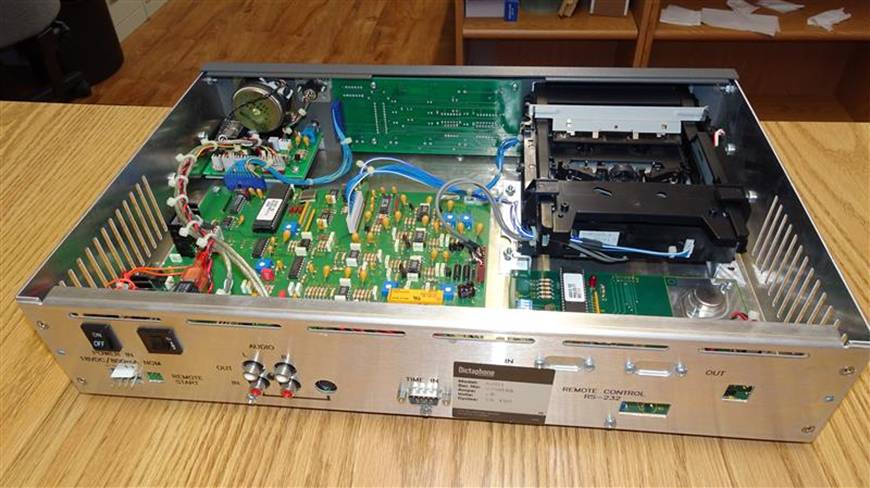










|
Dictaphone - Express Talk Digital Dictation System |

|
Electronics Engineering Career (page 1) |


|
Express Talk prototypes today, on display in my lab |

|
Express Talk literature collection |


|
Express Talk recorder interior. |
|
Looking for a job in late 1979 after graduating from FIT, what I really wanted was to design consumer electronics. Well, by this time most of that had already gone overseas with some work still being done in California. I ended up working at Dictaphone in Melbourne FL (or later the companies that would buy Dictaphone or the facility I worked in) for almost 29 years. I always knew it wouldn’t last.
Unwilling to move across the country, I saw Dictaphone as similar to consumer electronics, as they did make things that real people would pick up and use. With no experience and just out of college, I accepted a job as Test Engineer. I really didn’t enjoy that type of work, so I began offering redesigns of existing sub-assemblies that either reduced cost, assembly time or offered greater functionality. Even though it was a manufacturing facility, I began to reshape my job into design engineering. Here are just some of my projects at Dictaphone. There were countless others, big and small. |
|
Dictation machines at that time were based on a continuous tape loop that would gather in layers at the bottom of a bin. They nicknamed the machines “tanks”. A traditional reel-to-reel machine won't work because you have to allow a new dictation to be recorded at the same time a transcriber is playing back a previous dictation from any random place on the tape. While the “tanks” worked, it was mechanically complex, allowed a maximum of one dictator and one transcriber at a time and required maintenance such as head cleaning. |
|
At the time, hard disk drives were just starting to be affordable. They were now up to 10MB! I worked some numbers and found this was enough space to record a reasonable amount of compressed audio with a bandwidth sufficient for speech. I began experimenting on my own time, working on various compression techniques. I new there would be lots of data moving around and did not even bother with my favorite processor, the 6502. I jumped right to the MC68000 which was quite a powerhouse at the time. It ran at 8MHz and could directly address 16MB of memory! It was hard to imagine that you could ever need or afford that much memory. This was the same µP being designed into the first Apple MacIntosh. |
|
While I was working on this, Dictaphone did end up sourcing a small hard disk drive based dictation system from JVC. It was not expandable, but more importantly it still used our old analog dictate and transcribe stations. What I was working on would be expandable allowing up to 6 people to use the system at a time in any mix of dictation and transcription. But what really set it apart was that the A/D and D/A conversion was done in the stations and everything was sent digitally on a RS485 bus. Today, that seems obvious as everything is digital. But in the middle 80’s, it was a big step. This is what made my design the world’s first all-digital dictation system. During it’s product life I designed many additional peripheral devices such as telephone interfaces, handheld and handsfree dictate stations, etc. Also, I was always making provisions for ever increasing disk capacity. See .pdfs of the sales brochure and the in-house newsletter where they talk about my design. |
|
Dictaphone’s second major product line after dictation was “Loggers” or more formally Logging Recorders. They were reel-to-reel tape recorders with wide tape that would record up to 60 channels for 24 hours on one huge reel. These were most commonly used at police stations and 911 call centers. You would see these in the background on police shows and TV news would often show the logger while playing back 911 audio.
Our model 5000 Logger had a 7-segment LED display and keypad for a user interface, usually mounted at the top of the rack. In addition, the tape decks had the usual Stop, Play, FF etc. buttons. In, for example, a 911 call enter, in order to bring that control down to the console where dispatchers would be seated, we offered a “Remote” panel. This was another version of the LED/keypad user interface paralleling the signals from the main control unit in the main rack. It required a large multi-conductor cable.
CRT terminals were beginning to get reasonable at this point. One day it occurred to me why not put a terminal down on the 911 dispatcher’s console and show a graphic representation of all the controls and status on the screen? They could just hit keyboard buttons to control the logger. Yes all the same signals would have to be tapped for status and control, but that could all happen inside the logger. The cable over to the terminal only needs a few conductors for data in both directions, playback audio for a local speaker and ground.
I designed a 6502 based board which would look at all the signals in the Logger and be able to simulate actuation of all it’s controls. It mounted on top of the existing PCB in the loggers controller/user interface. It had an RS232 connector which went out to the remote terminal. While this was an expensive add-on, I think it sold pretty well.
My only hassle was that the terminal manufacturer, I think ADDS, changed the character generator and messed up the simple line graphics I was using to create a simple graphics representation of the logger controls. I ended up having to copy the character generator EPROM from an original terminal and have production open up new terminals and replace their character generator EPROM.
|
|
Dictaphone - Multi-Deck Backup Systems |


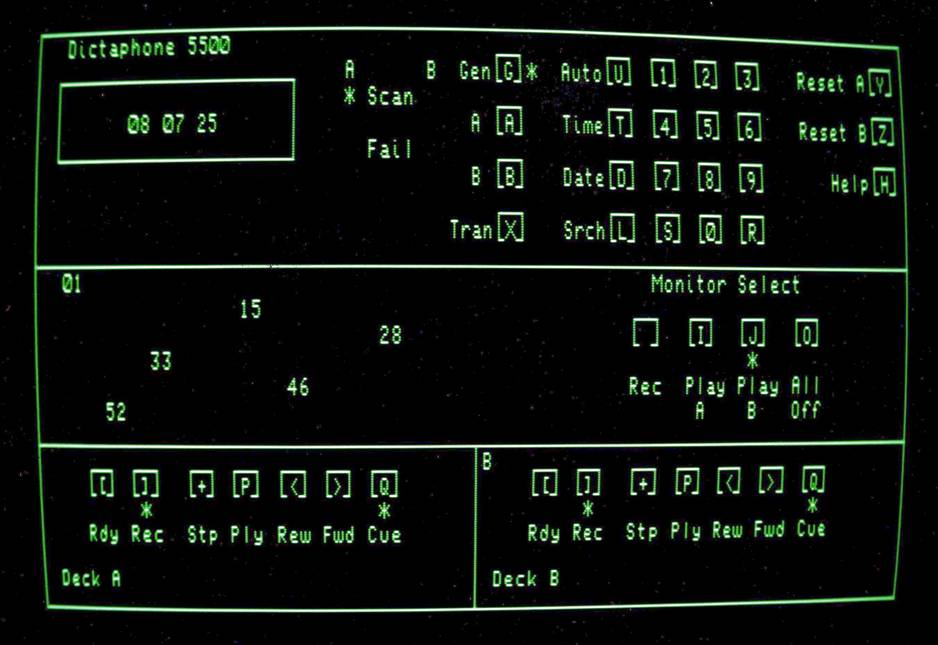
|
As you can see from the internal photo of the main unit, the recorder, the motherboard had the 68000. It also had 6 slots where communications boards could be plugged in. Each of these bds. had a 6502 µP, RAM, EPROM & and RS485 transceiver. This would create one 125Kbaud bus and would translate into one user, either dictate or transcribe. I used the fact that the 6502 really only needed access to memory during half it’s bus cycle to create dual ported RAM using only standard SRAM. The 68000, then, could sneak in during the unused part of the bus cycle and access each plug-in board’s RAM. This access was therefore transparent to both processors and allowed audio and control data to flow through buffer and handshake flag constructs I set up in RAM.
I had to develop the main 68000 software and at the same time write the software for the 6502s on the cards. It didn’t stop there, though, as I also had to write 6511 (an early Rockwell µC based on the 6502) software for the Dictate Station & Transcribe Station as they all interacted with the protocol I was putting together as I went along. All this on the prototype hardware for all these units which I designed somewhat in parallel. Looking back, I’m glad I did this in my 20s, as I don’t think I could keep it all straight today. |

|
Dictaphone 5000 Logger |
|
Photo of terminal’s CRT |
|
Dictaphone - Logger Computer Controlled Remote |
|
The typical logger had one main deck (recorder transport) and one backup deck. There were several customers who wanted more main decks with fewer backup decks. One was the Hong Kong Stock Exchange that wanted 4 main decks with only 1 backup. They figured when one failed and it transferred to the backup, they would immediately troubleshoot and get the failed unit back on line before a second one failed with no backup to go to.
Other customers also wanted various configurations. Several Hong Kong companies wanted various forms of backup, also the NYPD. Some wanted a huge number of phone lines to be switched to the next available record channel of a smaller bank of recorders. I think it was the Hong Kong Jockey Club that wanted that.
At any rate, I did lots of custom switching arrangements. All were processor controlled. For some, I had to design rather massive PCBs with multiple cross-point switch chips to direct the signals to their channels. The newspaper clipping to the right made it’s way back to me after one of the installations. |

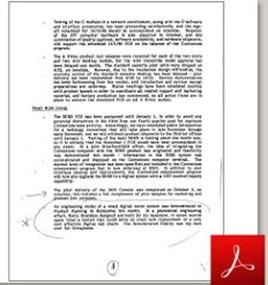
|
Dictaphone - Time Code Conversion & Slave Clocks |
|
Dictaphone had it’s own Time Code signal. It was devised to be recorded on the logger “behind” the voice channel. It was based on an amplitude modulated 40Hz signal. This put it below the 300-3000Hz range considered to contain voice, allowing it to be filtered out during playback. There was also a differential digital version of the Time Code that was output by the logger’s main controller. That signal was meant for external “slave” time displays around the 911 call center (for example), one of which was my design called the “Matrix Slave Clock”.
However, being that this was a proprietary signal, some customers wanted us to provide conversions to other types of time codes. I ended up designing many converters, both to and from our code. Most notable was probably the IRIG-E time code used throughout the world. I made units which converted Dictaphone Time Code to IRIG-E and also units which accepted IRIG-E and either generated our code or directly set the logger’s time to match it.
There were countless other special clock interfaces, WWV receivers, Time Code to RS232 etc. I also designed a Time Code to Voice unit which would decode the signal and speak the time, typically to record on one channel of a cassette recorder while the desired audio from the logger was recorded on the other channel. That way you could have a standard stereo cassette player let you hear the conversation and voice time stamp, possibly to take to court.
|
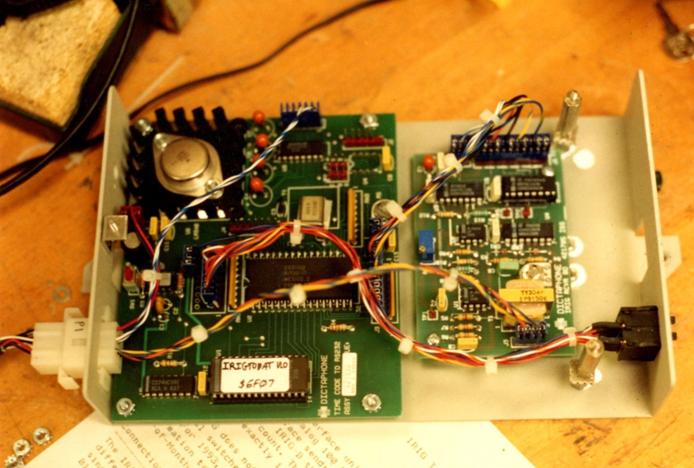
|
There were lots of special time conversion projects. This one happens to be IRIGTODAT. I was lucky enough to find this photo on the web, but it’s just an example of what most of these converters looked like physically. You can see my handwriting on the EPROM label. |
|
Dictaphone - Rerecord Cassette Recorder for Loggers |
|
If you wanted to search the logger and find the audio you are interested in, you could put on that day’s big reel of tape, punch in the time and the logger would do a rather impressive hi-speed back and forth search. Once you found what you were looking for, you might want to dub it off onto a cassette to take with you. For loggers used in law enforcement, the predominant market, you are probably a police detective, lawyer, FBI agent, etc.
While there was a record output jack on every logger, Dictaphone wanted to offer a dedicated cassette recorder with many handy features. One of the features I put in was a speech synthesizer. Digital Time Code would come in from the logger during playback. The desired audio would be recorded on one of the cassette’s stereo channels, and a synthesized voice would speak the time on the other channel. That gave you a cassette that you could play on any consumer stereo player and have a built in time stamp.
This Rerecod was one of the few projects where I worked with someone else. Fellow engineer and friend Jose designed the analog electronics and I designed the rest. We had a great time planning and putting this together.
When I started to write this entry for the website, I looked through my remaining Dictaphone printed materials hoping to find a sales brochure or a printed version of the operator’s manual. I still have the Word file for the manual which I wrote at the time, of course, but no official material. So I went out on the web hopeful of finding a brochure, but found nothing.
Amazingly, the search showed a current ebay auction for an actual Dictaphone 6201 Rerecord! They wanted $199 plus $36 shipping. I couldn’t justify that for another piece of nostalgia to add to my little museum of things I designed, so I offered $50 plus shipping. Yesterday they accepted and it is now on it’s way to me.
Here in my new basement lab in TN, I’ve set aside some space for a little museum of things I’ve designed over the years, both in my career and hobby projects. I only have what I managed to hold on to, but there are a lot of the big ones represented here. That includes my Express Talk system, Alien Sidestep cartridge, etc. I didn’t put much effort into it until Linda said I should really expand the area and display all that I had. I’m so glad she said that, as I often look it over and reminisce about creating all these things. |
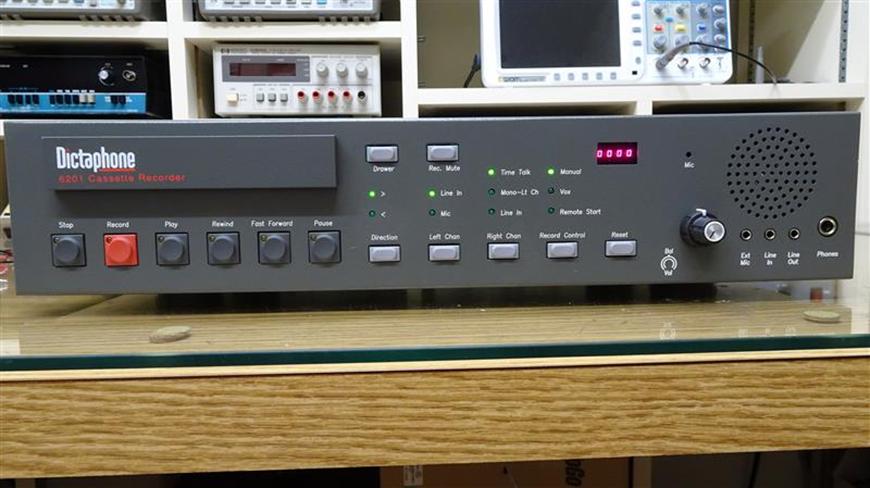
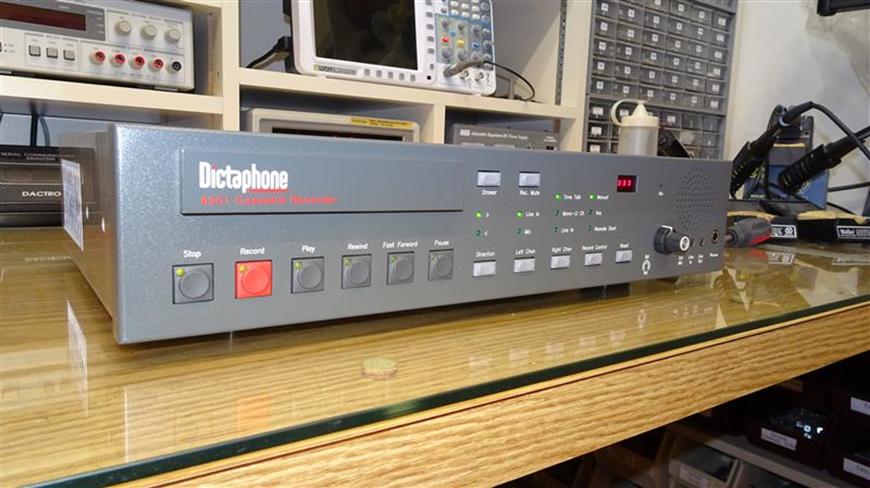
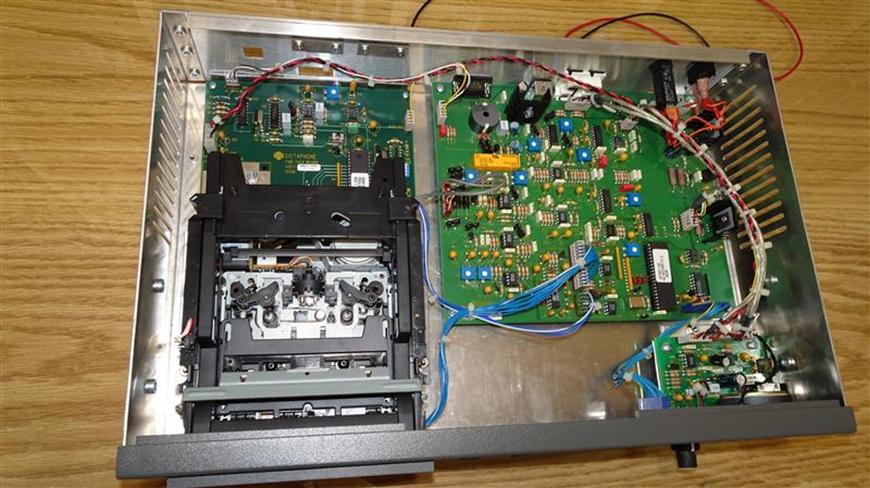

|
Kerry at Dictaphone sitting at bench 1990-02-22 |
